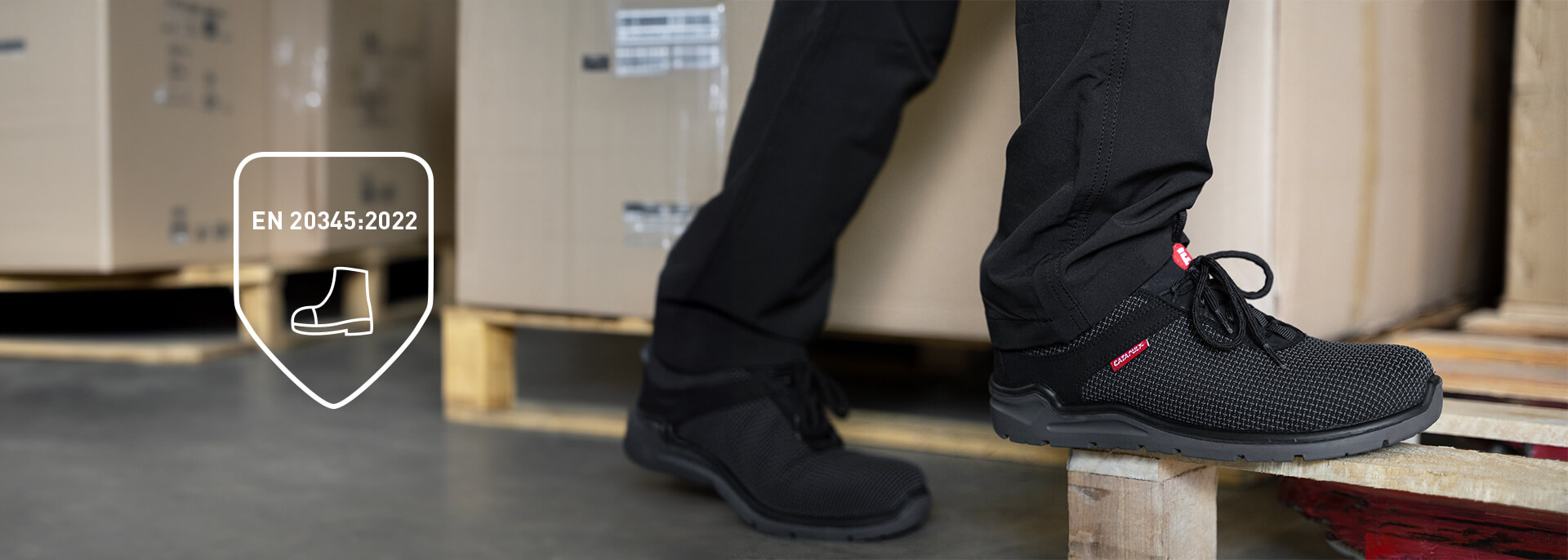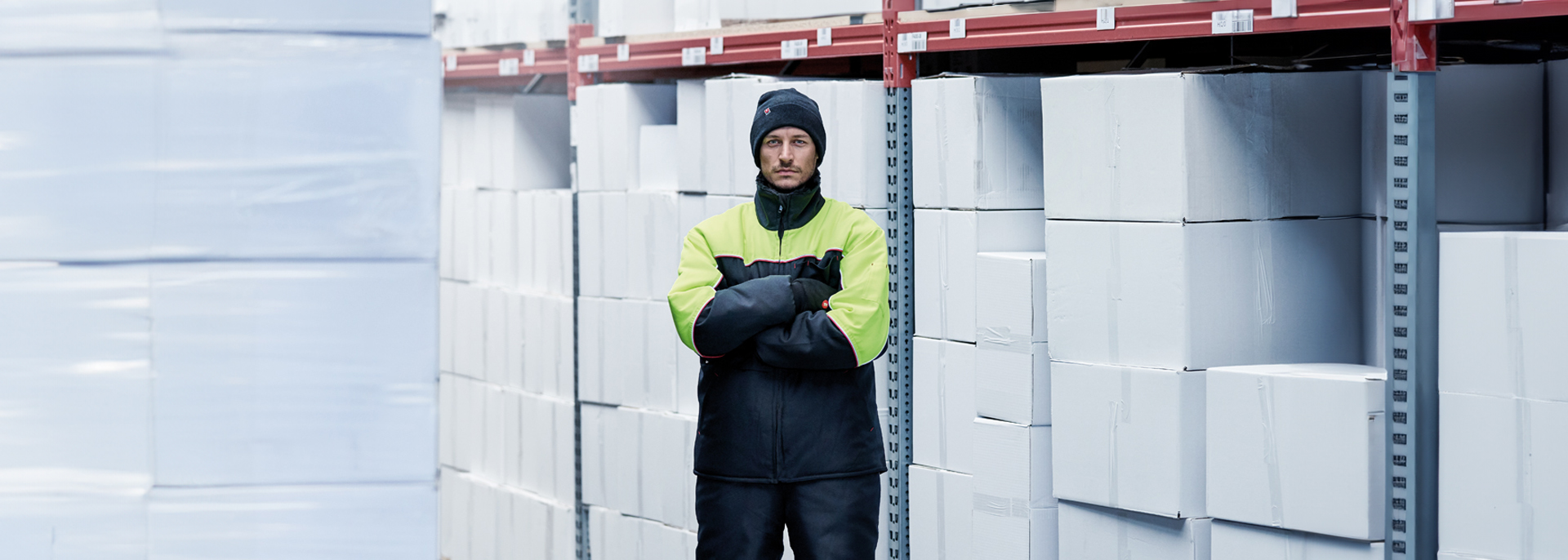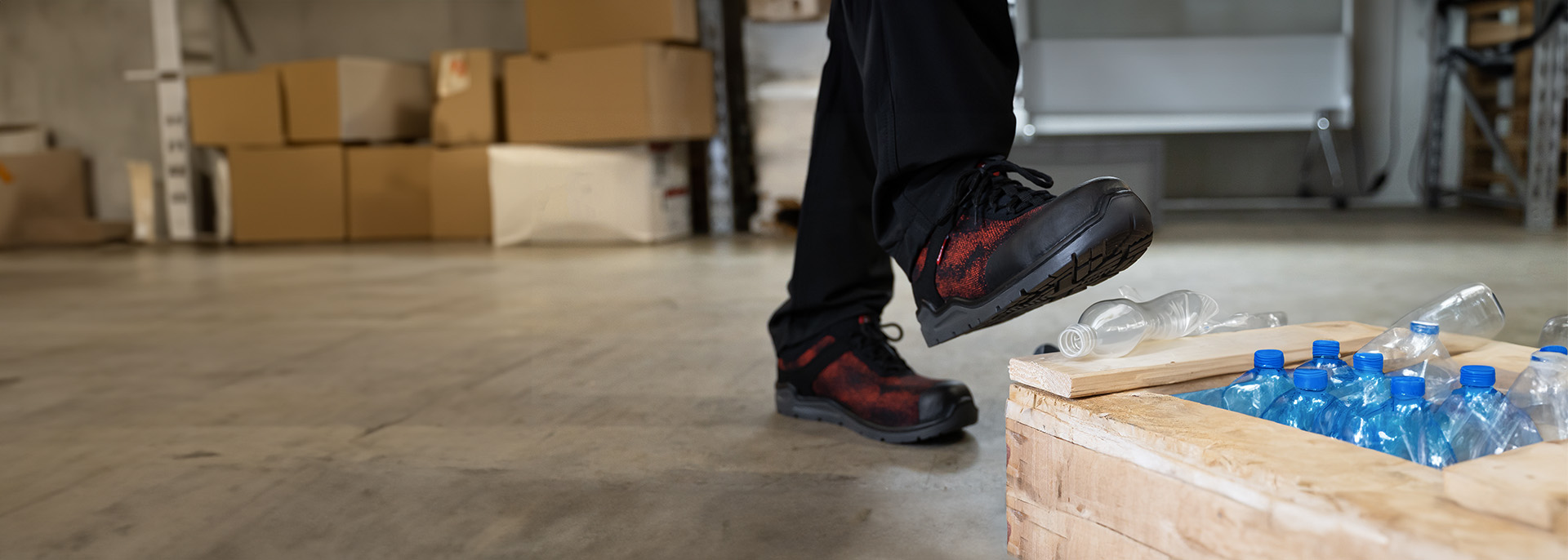
Certifications | Worth Knowing
The New Shoe Standard EN ISO 20345:2022 – An Insight into the Most Important Innovations

Regardless of the industry, safety footwear is essential in almost all sectors, such as logistics and warehousing, to protect employees at work.
Safety footwear was previously subject to the requirements of the EN ISO 20345:2011 standard, but this 2012 standard has now been replaced or updated by a new version, EN ISO 20345:2022.
The EN ISO 20345:2022 version specifies the basic requirements as well as additional, optional requirements for safety footwear. These include protection against mechanical risks, slip resistance, protection against heat and cold and ergonomic features.
In this article, we explain the changes in the new standard and the differences to the old one.
Which classes are there?
- Class I (Category: SB, S1, S1P, S1PL, S1PS, S2, S3, S3L, S3S, S6, S7, S7L, S7S): Footwear made of leather or other materials, except solid rubber or all-polymer footwear
- Class II (Category: SB, S4, S5, S5L, S5S): Total polymer shoes including solid rubber shoes
Compared to the previous standard EN ISO 20345:2011, the categories S1P (updated), S1PL, S1PS, S3L, S3S, S6, S7, S7L, S7S, S5L and S5S have been added.
What are the new categories?
Two new categories of safety shoes have been introduced:
- S6: These shoes are similar to safety shoes of category S2, but are additionally permanently waterproof due to a special weather protection membrane
- S7: These shoes match safety shoes of category S3, but are permanently waterproof due to a special weather protection membrane. In addition, there are the new variants S7L and S7S, in which the water resistance (WR) is already integrated.
The changes to water resistance (WR)
In the past, safety shoes of categories S2 or S3 had a water-repellent uppper, which was defined by the Water Repellent Upper (WRU) label.
However, only the material itself was tested for this labelling. If this upper material had been integrated into the safety shoes, water would have been able to penetrate through the seams, making the safety shoes no longer completely water-repellent.
The new standard replaces the WRU labelling in favour of the Water Penetration and Absorption (WPA) and Water Resistence (WR) labels.
As a result, the new labelling provides more precise information about the water resistance by taking into account the material as well as the entire shoe construction. This means that not only the upper material, but the whole shoe is tested to ensure that no water can penetrate the safety shoes.
New features in Slip Resistance (SR)
With regard of the slip resistance, further amendments were made to the standard EN ISO 20345:2022. Peviously, the slip resistance of safety shoes was labelled as SRA, SRB and SRC. These labels no longer exist in the new standard.
Instead, the shoes are now tested in a different way. Each shoe has to fulfil a basic slip resistance on ceramic tiles with a special cleaning solution (sodium lauryl sulphate solution). However, this basic slip resistance is no longer labelled separately, as was previously the case with SRA labelling.
In addition, shoe soles can be voluntarily tested on ceramic tiles with glycerine. If the shoes pass this test, they are labelled with SR, which indicates the highest slip resistance.
Shoes certified according to the previous standard EN ISO 20345:2011 will retain their old labelling (SRA, SRB or SRC) until their certificates expire.
Footwear with special features, such as cleats, which are difficult to test according to the standard, must also be labelled with a special symbol (Ø).
New requirements for perforation resistance
The new standard EN ISO 20345:2022 provides a more precise differentiation in penetration resistance, now referred as "perforation resistance", to clarify that safety footwear does not offer absolute protection against penetration.
Previously, safety shoes with perforation resistance, also known as nail perforation resistance, were only labelled with a "P" without specifying the material of the protection. The standard EN ISO 20345:2022 defines precisely what the penetration-resistant sole is made of and the diameter of the test nail.
The measurement of the perforation resistance is conducted using a test nail with a conical tip. The conical tip has the shape of a cone. This shape is used to ensure an even and focues loading.
The new labels are:
-
P – Metal puncture-resistant sole of steel (S1P, S3, S5, S7)
- Diameter test nail: 4,5 mm with conical tip
- The strength for puncturing the sole should not be less than 1100 N
-
PL – Non-metallic puncture-resistant sole of textile in accordance with basic requirements (+L) (S1PL, S3L, S5L, S7L)
- Diameter test nail: 4,5 mm with conical tip
- The strength for puncturing the sole should not be less than 1100 N
- In addition, the layers of the sole should not be separated at any of the test points
-
PS - Non-metallic puncture-resistant sole of textile in accordance with higher requirements (+S) (S1PS, S3S, S5S, S7S)
- Diameter test nail: 3 mm with conical tip
- The strength for puncturing the sole must not be less than 1100 N in the resulting average, detemined on the basis of four individual tests
- No separation of the layers may occur at the test points
Test results in accordance with the standard EN ISO 22568-2:2019 are required for protective toe caps made of non-metallic material, while the standard EN ISO 22568-1:2019 applies to metallic protective toe caps.
The basic requirements and necessary additional requirements at a glance:
| Category | Classification | Toe cap | Closed heel area | Antistatic (A) | Treaded sole class I: Profile height ≥ 2,5 mm | Treaded sole class II: Profile height ≥ 4 mm | Energy Absorption in heel area (E) | P: Metal midsole | PL: Non-metallic midsole | PS: Non-metallic midsole | Water Resistance (WR) | Water Penetration and Water Absorption (WPA) – at least 60 Min. |
|---|---|---|---|---|---|---|---|---|---|---|---|---|
| SB | I or II | ✔ | Open heel area possible | (✔) | (✔) | (✔) | ||||||
| S1 | I | ✔ | ✔ | ✔ | (✔) | ✔ | ||||||
| S1P | I | ✔ | ✔ | ✔ | (✔) | ✔ | ✔ | |||||
| S1PL | I | ✔ | ✔ | ✔ | (✔) | ✔ | ✔ | |||||
| S1PS | I | ✔ | ✔ | ✔ | (✔) | ✔ | ✔ | |||||
| S2 | I | ✔ | ✔ | ✔ | (✔) | ✔ | ✔ (then it is S6) | ✔ | ||||
| S6 | I | ✔ | ✔ | ✔ | (✔) | ✔ | ✔ | ✔ | ||||
| S3 | I | ✔ | ✔ | ✔ | ✔ | ✔ | ✔ | ✔ (then it is S7) | ✔ | |||
| S3L | I | ✔ | ✔ | ✔ | ✔ | ✔ | ✔ | ✔ | ||||
| S3S | I | ✔ | ✔ | ✔ | ✔ | ✔ | ✔ | ✔ | ||||
| S7 | I | ✔ | ✔ | ✔ | ✔ | ✔ | ✔ | ✔ | ✔ | |||
| S7L | I | ✔ | ✔ | ✔ | ✔ | ✔ | ✔ | ✔ | ✔ | |||
| S7S | I | ✔ | ✔ | ✔ | ✔ | ✔ | ✔ | ✔ | ✔ | |||
| S4 | II | ✔ | ✔ | ✔ | (✔) | ✔ | ✔ | ✔ | ||||
| S5 | II | ✔ | ✔ | ✔ | ✔ | ✔ | ✔ | ✔ | ✔ | |||
| S5L | II | ✔ | ✔ | ✔ | ✔ | ✔ | ✔ | ✔ | ✔ | |||
| S5S | II | ✔ | ✔ | ✔ | ✔ | ✔ | ✔ | ✔ | ✔ |
✔ must be fulfilled (✔) can be fulfilled
New and modified additional requirements and codes:
New additional requirements for safety shoes have also been introduced, focussing on slip resistance, abrasion of overcaps and grip on ladders.
- Scuff Cap (SC): A Martindale abrasion test with 8,000 cycles is carried out. After this test, the cap may not show any holes that go through its entire thickness.
- Ladder Grip (LG): The outsole in the joint area of the safety shoe needs to have a transverse profile with a height of at least 1.5 mm. This ensures a better grip on ladders.
- Resistance to Fuel and Oil (FO): The test of resistance to fuel and oil is optional in the new standard and is no longer mandatory.
An overview of all new, unchanged and amended additional requirements:
| Codes | Term | Annotation |
|---|---|---|
| A | Antistatic | |
| AN | Ankle Protection | |
| CI | Cold Insultaion | |
| HI | Heat Insulation | |
| CR | Cut Resistance | |
| E | Energy Absorption (in the heel area) | |
| FO | Resistance to Fuel and Oil | |
| LG | Ladder Grip | |
| M | Metatarsal Protection | |
| WR | Water Resistance | |
| WPA | Water Penetration & Absorption | |
| C | Conductivity | |
| P | Perforation Resistance, Steel Midsole | |
| PL | Perforation Resistance, Non-metallic Midsole, Large nail | |
| PS | Perforation Resistance, Non-metallic Midsole, Small nail | |
| SC | Suff Cap (Abrasion of the protective cap) | |
| HRO | Heat Resistance Outsole (Contact heat behaviour) | |
| SR | Slip Resistance (Slip resistance ceramic tiles / glycerine) |
Conclusion
In the end, safety footwear plays a crucial role in occupational health and safety, and the update of the EN ISO 20345:2022 standard brings important changes. This version introduces clearer standards, particularly in relation to waterproofing, slip resistance and penetration resistance. New categories and labelling provide a more precise safety assessment for different working environments. To summarise, the new standards represent an important step towards improving safety in the workplace and further enhancing the quality of safety footwear.






